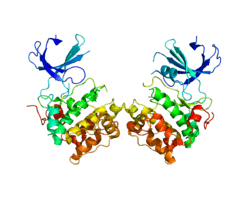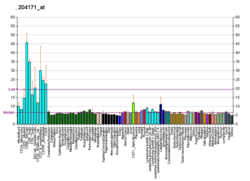P70-S6 Kinase 1
Ribosomal protein S6 kinase beta-1 (S6K1), also known as p70S6 kinase (p70S6K, p70-S6K), is an enzyme (specifically, a protein kinase) that in humans is encoded by the RPS6KB1 gene.[5][6] It is a serine/threonine kinase that acts downstream of PIP3 and phosphoinositide-dependent kinase-1 in the PI3 kinase pathway.[7] As the name suggests, its target substrate is the S6 ribosomal protein.[8] Phosphorylation of S6 induces protein synthesis at the ribosome.
The phosphorylation of p70S6K at threonine 389 has been used as a hallmark of activation by mTOR and correlated with autophagy inhibition in various situations. However, several recent studies suggest that the activity of p70S6K plays a more positive role in the increase of autophagy.[9][10]
Function
This gene encodes a member of the RSK family of serine/threonine kinases. This kinase contains 2 non-identical kinase catalytic domains and phosphorylates several residues of the S6 ribosomal protein. The kinase activity of this protein leads to an increase in protein synthesis and cell proliferation. Amplification of the region of DNA encoding this gene and overexpression of this kinase are seen in some breast cancer cell lines. Alternate translational start sites have been described and alternate transcriptional splice variants have been observed but have not been thoroughly characterized.
mTOR
The p70S6 kinase is a downstream target of mTOR (mammalian target of rapamycin) signaling, specifically mTORC1, an mTOR-containing complex characterized by the inclusion of Raptor rather than Rictor (mTORC2). mTOR can be activated via an AND-gate-like mechanism at the lysosome, integrating signals about growth factors and bioavailability of important molecules. For instance, amino acids such as arginine and leucine can trigger lysosomal recruitment of mTORC1. Once at the lysosome, mTOR can be activated by Rheb, a small, lysosomal-resident GTPase, in its GTP-bound state. Rheb GTPase activity is stimulated (and therefore capacity to activate mTOR diminished) by the upstream TSC complex, which is inhibited by IGF signalling. Thus, the AND gate consists of proper localization by sufficiency of amino acids and activation by growth factors. Once mTOR has been properly localized and activated, it can phosphorylate downstream targets such as p70S6K, 4EBP, and ULK1 which are important for regulating protein anabolic/catabolic balance.
Physical exercise activates protein synthesis via phosphorylation (activation) of p70S6K in a pathway that is dependent on mTOR, specifically mTORC1. This has been demonstrated by using an inhibitor of mTOR, rapamycin, to block an increase in muscle mass, despite increases in load (e.g., exercise). Exercise has been shown to increase levels of IGF-1 in muscle, thus inducing the IGF-1/PI3K/Akt/p70S6K signaling pathway, and thereby increasing the protein synthesis required to build muscle.
Clinical significance
Inhibition of the S6K1 protein, or a lack of it, slows the production of adipose (fat) cells by disrupting and retarding the initial "commitment stage" of their formation. The study could have implications for the treatment of obesity.[11]
Amplification of the region of DNA encoding this gene and overexpression of this kinase are seen in some breast cancer cell lines.
Another pathway for which P70 has proposed involvement is in muscle lengthening and growing. P70 is phosphorylated by passive stretch in the soleus muscle. This may be one of many protein kinases involved in muscle building.[12]
In its inactive state, S6K1 is bound to eIF3 and detaches following phosphorylation by mTOR/Raptor. Free S6K1 is then able to phosphorylate a number of its targets, including eIF4B.[13]
Interactions
P70-S6 Kinase 1 has been shown to interact with:
See also
- Ribosomal S6 kinase
- RPS6KA1
References
- GRCh38: Ensembl release 89: ENSG00000108443 - Ensembl, May 2017
- GRCm38: Ensembl release 89: ENSMUSG00000020516 - Ensembl, May 2017
- "Human PubMed Reference:". National Center for Biotechnology Information, U.S. National Library of Medicine.
- "Mouse PubMed Reference:". National Center for Biotechnology Information, U.S. National Library of Medicine.
- Grove JR, Banerjee P, Balasubramanyam A, Coffer PJ, Price DJ, Avruch J, Woodgett JR (Nov 1991). "Cloning and expression of two human p70 S6 kinase polypeptides differing only at their amino termini". Molecular and Cellular Biology. 11 (11): 5541–50. doi:10.1128/mcb.11.11.5541. PMC 361924. PMID 1922062.
- "Entrez Gene: RPS6KB1 ribosomal protein S6 kinase, 70kDa, polypeptide 1".
- Chung J, Grammer TC, Lemon KP, Kazlauskas A, Blenis J. (1994). "PDGF- and insulin-dependent pp70S6k activation mediated by phosphatidylinositol-3-OH kinase". Nature. 370 (6484): 71–75. doi:10.1038/370071a0. PMID 8015612.CS1 maint: uses authors parameter (link)
- Chung J, Kuo CJ, Crabtree GR, Blenis J. (1992). "Rapamycin-FKBP specifically blocks growth-dependent activation of and signaling by the 70 kd S6 protein kinases". Cell. 69 (7): 1227–1236. doi:10.1016/0092-8674(92)90643-Q. PMID 1377606.CS1 maint: uses authors parameter (link)
- Datan E, Shirazian A, Benjamin S, Matassov D, Tinari A, Malorni W, Lockshin RA, Garcia-Sastre A, Zakeri Z (2014). "mTOR/p70s6k signaling distinguishes routine, maintenance-level autophagy from autophagic cell death during influenza infection". Virology. 452-453 (march 2014): 175–190. doi:10.1016/j.virol.2014.01.008. PMC 4005847. PMID 24606695.
- Ci Y, Shi K, An J, Yang Y, Hui K, Wu P, Shi L, Xu C (2014). "ROS inhibit autophagy by downregulating ULK1 mediated by the phosphorylation of p53 in selenite-treated NB4 cells". Cell Death and Disease. 5 (november 2014): 1–10. doi:10.1038/cddis.2014.506. PMC 4260759. PMID 25429619.
- Carnevalli LS, Masuda K, Frigerio F, Le Bacquer O, Um SH, Gandin V, Topisirovic I, Sonenberg N, Thomas G, Kozma SC (May 2010). "S6K1 plays a critical role in early adipocyte differentiation". Developmental Cell. 18 (5): 763–74. doi:10.1016/j.devcel.2010.02.018. PMC 2918254. PMID 20493810.
- Van Dyke JM, Bain JL, Riley DA (Jan 2014). "Stretch-activated signaling is modulated by stretch magnitude and contraction". Muscle & Nerve. 49 (1): 98–107. doi:10.1002/mus.23880. PMID 23620271.
- Holz, Marina K.; Ballif, Bryan A.; Gygi, Steven P.; Blenis, John (2005). "mTOR and S6K1 Mediate Assembly of the Translation Preinitiation Complex through Dynamic Protein Interchange and Ordered Phosphorylation Events". Cell. 123 (4): 569–580. doi:10.1016/j.cell.2005.10.024. PMID 16286006. Retrieved 1 March 2016.
- Nemazanyy I, Panasyuk G, Zhyvoloup A, Panayotou G, Gout IT, Filonenko V (Dec 2004). "Specific interaction between S6K1 and CoA synthase: a potential link between the mTOR/S6K pathway, CoA biosynthesis and energy metabolism". FEBS Letters. 578 (3): 357–62. doi:10.1016/j.febslet.2004.10.091. PMID 15589845.
- Panasyuk G, Nemazanyy I, Zhyvoloup A, Bretner M, Litchfield DW, Filonenko V, Gout IT (Oct 2006). "Nuclear export of S6K1 II is regulated by protein kinase CK2 phosphorylation at Ser-17". The Journal of Biological Chemistry. 281 (42): 31188–201. doi:10.1074/jbc.M602618200. PMID 16895915.
- Holz MK, Ballif BA, Gygi SP, Blenis J (Nov 2005). "mTOR and S6K1 mediate assembly of the translation preinitiation complex through dynamic protein interchange and ordered phosphorylation events". Cell. 123 (4): 569–80. doi:10.1016/j.cell.2005.10.024. PMID 16286006.
- Ali SM, Sabatini DM (May 2005). "Structure of S6 kinase 1 determines whether raptor-mTOR or rictor-mTOR phosphorylates its hydrophobic motif site". The Journal of Biological Chemistry. 280 (20): 19445–8. doi:10.1074/jbc.C500125200. PMID 15809305.
- Ha SH, Kim DH, Kim IS, Kim JH, Lee MN, Lee HJ, Kim JH, Jang SK, Suh PG, Ryu SH (Dec 2006). "PLD2 forms a functional complex with mTOR/raptor to transduce mitogenic signals". Cellular Signalling. 18 (12): 2283–91. doi:10.1016/j.cellsig.2006.05.021. PMID 16837165.
- Hara K, Maruki Y, Long X, Yoshino K, Oshiro N, Hidayat S, Tokunaga C, Avruch J, Yonezawa K (Jul 2002). "Raptor, a binding partner of target of rapamycin (TOR), mediates TOR action". Cell. 110 (2): 177–89. doi:10.1016/S0092-8674(02)00833-4. PMID 12150926.
- Nojima H, Tokunaga C, Eguchi S, Oshiro N, Hidayat S, Yoshino K, Hara K, Tanaka N, Avruch J, Yonezawa K (May 2003). "The mammalian target of rapamycin (mTOR) partner, raptor, binds the mTOR substrates p70 S6 kinase and 4E-BP1 through their TOR signaling (TOS) motif". The Journal of Biological Chemistry. 278 (18): 15461–4. doi:10.1074/jbc.C200665200. PMID 12604610.
- Chiang GG, Abraham RT (Jul 2005). "Phosphorylation of mammalian target of rapamycin (mTOR) at Ser-2448 is mediated by p70S6 kinase". The Journal of Biological Chemistry. 280 (27): 25485–90. doi:10.1074/jbc.M501707200. PMID 15899889.
- Holz MK, Blenis J (Jul 2005). "Identification of S6 kinase 1 as a novel mammalian target of rapamycin (mTOR)-phosphorylating kinase". The Journal of Biological Chemistry. 280 (28): 26089–93. doi:10.1074/jbc.M504045200. PMID 15905173.
- Isotani S, Hara K, Tokunaga C, Inoue H, Avruch J, Yonezawa K (Nov 1999). "Immunopurified mammalian target of rapamycin phosphorylates and activates p70 S6 kinase alpha in vitro". The Journal of Biological Chemistry. 274 (48): 34493–8. doi:10.1074/jbc.274.48.34493. PMID 10567431.
- Long X, Lin Y, Ortiz-Vega S, Yonezawa K, Avruch J (Apr 2005). "Rheb binds and regulates the mTOR kinase". Current Biology. 15 (8): 702–13. doi:10.1016/j.cub.2005.02.053. PMID 15854902.
- Toral-Barza L, Zhang WG, Lamison C, Larocque J, Gibbons J, Yu K (Jun 2005). "Characterization of the cloned full-length and a truncated human target of rapamycin: activity, specificity, and enzyme inhibition as studied by a high capacity assay". Biochemical and Biophysical Research Communications. 332 (1): 304–10. doi:10.1016/j.bbrc.2005.04.117. PMID 15896331.
- Saitoh M, Pullen N, Brennan P, Cantrell D, Dennis PB, Thomas G (May 2002). "Regulation of an activated S6 kinase 1 variant reveals a novel mammalian target of rapamycin phosphorylation site". The Journal of Biological Chemistry. 277 (22): 20104–12. doi:10.1074/jbc.M201745200. PMID 11914378.
- Kim DH, Sarbassov DD, Ali SM, King JE, Latek RR, Erdjument-Bromage H, Tempst P, Sabatini DM (Jul 2002). "mTOR interacts with raptor to form a nutrient-sensitive complex that signals to the cell growth machinery". Cell. 110 (2): 163–75. doi:10.1016/S0092-8674(02)00808-5. PMID 12150925.
- Edinger AL, Linardic CM, Chiang GG, Thompson CB, Abraham RT (Dec 2003). "Differential effects of rapamycin on mammalian target of rapamycin signaling functions in mammalian cells". Cancer Research. 63 (23): 8451–60. PMID 14679009.
- Leone M, Crowell KJ, Chen J, Jung D, Chiang GG, Sareth S, Abraham RT, Pellecchia M (Aug 2006). "The FRB domain of mTOR: NMR solution structure and inhibitor design". Biochemistry. 45 (34): 10294–302. doi:10.1021/bi060976+. PMID 16922504.
- Takahashi T, Hara K, Inoue H, Kawa Y, Tokunaga C, Hidayat S, Yoshino K, Kuroda Y, Yonezawa K (Sep 2000). "Carboxyl-terminal region conserved among phosphoinositide-kinase-related kinases is indispensable for mTOR function in vivo and in vitro". Genes to Cells. 5 (9): 765–75. doi:10.1046/j.1365-2443.2000.00365.x. PMID 10971657.
- Burnett PE, Barrow RK, Cohen NA, Snyder SH, Sabatini DM (Feb 1998). "RAFT1 phosphorylation of the translational regulators p70 S6 kinase and 4E-BP1". Proceedings of the National Academy of Sciences of the United States of America. 95 (4): 1432–7. doi:10.1073/pnas.95.4.1432. PMC 19032. PMID 9465032.
- Sarbassov DD, Sabatini DM (Nov 2005). "Redox regulation of the nutrient-sensitive raptor-mTOR pathway and complex". The Journal of Biological Chemistry. 280 (47): 39505–9. doi:10.1074/jbc.M506096200. PMID 16183647.
- Richardson CJ, Bröenstrup M, Fingar DC, Jülich K, Ballif BA, Gygi S, Blenis J (Sep 2004). "SKAR is a specific target of S6 kinase 1 in cell growth control". Current Biology. 14 (17): 1540–9. doi:10.1016/j.cub.2004.08.061. PMID 15341740.
- Peterson RT, Desai BN, Hardwick JS, Schreiber SL (Apr 1999). "Protein phosphatase 2A interacts with the 70-kDa S6 kinase and is activated by inhibition of FKBP12-rapamycinassociated protein". Proceedings of the National Academy of Sciences of the United States of America. 96 (8): 4438–42. doi:10.1073/pnas.96.8.4438. PMC 16350. PMID 10200280.
- Bishop JD, Nien WL, Dauphinee SM, Too CK (Aug 2006). "Prolactin activates mammalian target-of-rapamycin through phosphatidylinositol 3-kinase and stimulates phosphorylation of p70S6K and 4E-binding protein-1 in lymphoma cells". The Journal of Endocrinology. 190 (2): 307–12. doi:10.1677/joe.1.06368. PMID 16899564.
- Panasyuk G, Nemazanyy I, Filonenko V, Gout I (May 2008). "Ribosomal protein S6 kinase 1 interacts with and is ubiquitinated by ubiquitin ligase ROC1". Biochemical and Biophysical Research Communications. 369 (2): 339–43. doi:10.1016/j.bbrc.2008.02.016. PMID 18279656.
External links
- Overview of all the structural information available in the PDB for UniProt: P23443 (Ribosomal protein S6 kinase beta-1) at the PDBe-KB.






